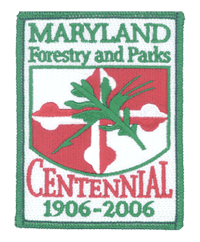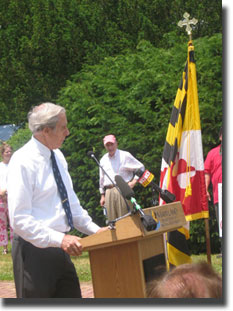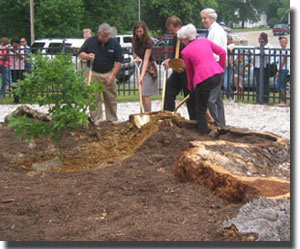 Grandson of Maryland’s First State Forester Recalls… Some Legacies of the Wye Oak
Grandson of Maryland’s First State Forester Recalls… Some Legacies of the Wye Oak
Speech given by Kirk P. Rodgers -
June 6, 2006
 I want to talk about two of the legacies of
the great tree that stood on this spot for more than 450 years. The Wye Oak was
a spectacular giant and there can be little question that my grandfather, Fred
W. Besley, Maryland’s first State Forester was inspired by it and that it added
to his determination to establish the Big Tree Champion Program here in
Maryland.
I want to talk about two of the legacies of
the great tree that stood on this spot for more than 450 years. The Wye Oak was
a spectacular giant and there can be little question that my grandfather, Fred
W. Besley, Maryland’s first State Forester was inspired by it and that it added
to his determination to establish the Big Tree Champion Program here in
Maryland.
When he first saw the tree in 1909 he had
already noted the impressive number of big trees here in Maryland and was
beginning to collect information about them. He recognized that the state has
large variations in climate and topography which provide conditions for a large
variety of species. As time passed he began to be more and more systematic in
making measurements and taking photographs of big trees. He worked almost alone
for 15 years in documenting them. But public interest had also begun to grow
and by 1925 the enthusiasm for big trees had reached the point where the
Maryland Forestry Association (a precursor to today’s Maryland Forests
Association) decided to sponsor a state wide Big Tree Contest. Prizes were
offered and rules were adopted for the contest. Besley designed a standard
measurement system to assure fair competition and he acted as an umpire in the
contest. 450 trees were entered and the winners were declared for 155 different
species. This contest captured great interest and by 1937 the Maryland Big Tree
list was revised and published.
Over the years the supremacy of the Wye Oak,
as the largest white oak in the state, was challenged many times but it always
held its own in these contests. There began to be a belief that in fact it was
the largest white oak in the nation. Then in 1940 the American Forestry
Association through its magazine “American Forests” inaugurated a big tree
contest for the whole United States modeled along the lines of the Maryland
contest and using the system of measurements developed by Fred Besley with minor
modifications. In that contest Maryland led the nation with 15 champions.
Among them of course was the Wye Oak. The inspiration provided by this tree
thus played a role in an important program which is underway today across our
whole nation.
As a footnote I should mention that the Spring
2006 issue of “American Forests” contains “The National Register of Big Trees
2006-2007.” Sadly of course our Wye Oak has now been replaced by a different
white oak which is located in Lawrenceville, Virginia. But clearly the Big Tree
Champion Program which had its origin here in Maryland goes forward with
strength at the national level.
Grandfather never forgot the Wye Oak, even
after he retired from state service in 1942. When he and my father purchased
forest land in the Lower Eastern Shore in the forties our family began to travel
regularly through this area. I personally cannot begin to count the number of
times that we detoured off Route 50 to the spot where we stand today. It was
like a pilgrimage or a visit to an old and dear friend. All of my family was
impacted by the loss of the great tree in 2002.
But trees like people live on through their
offspring and the Wye Oak has had many many offspring. So a second great legacy
of this tree is its progeny which continue to inspire and raise the spirits of
those fortunate enough to have planted one on their land.
In the 1930’s and 40’s it was estimated that
the tree was producing 7000 to 8000 acorns each year. When Governor O’Conner
declared June 1, 1941 as State Tree Day, Fred Besley promptly announced that
1,000 Wye Oak seedlings would be made available to garden clubs and other
responsible groups for planting.
 So 65 years ago almost to this day a
significant program of planting of “children” of the Wye Oak got underway.
Those original seedlings were the offspring of the 1939 acorn crop. They
averaged 2 feet in height and each carried an official certificate of parentage
signed by Besley guaranteeing that each seedling had “the inherent qualities of
the famous Wye Oak” Those “Wye Oak Juniors”, as they came to be known, are 67
years old today and they are planted all over the state.
So 65 years ago almost to this day a
significant program of planting of “children” of the Wye Oak got underway.
Those original seedlings were the offspring of the 1939 acorn crop. They
averaged 2 feet in height and each carried an official certificate of parentage
signed by Besley guaranteeing that each seedling had “the inherent qualities of
the famous Wye Oak” Those “Wye Oak Juniors”, as they came to be known, are 67
years old today and they are planted all over the state.
Many, many more
seedlings were established from acorns of the great tree in the years that
followed. I even have one planted next to the log cabin that Grandfather helped
to build near the town of Woolford in Dorchester County, not far from here.
Perhaps some of you in the audience have one also.
Today (June 6, 2006) we plant a duplicate of the Wye Oak and
we do so on a most appropriate occasion during the Maryland Forestry and Parks
Centennial. If Grandfather were here with us he would be amazed at the advance
in technology. He would be sad that the tree which inspired him is gone, but he
would be grateful about what we are doing on this day.
Note: This article was adapted
from a speech given by Kirk P. Rodgers, grandson of Maryland's first State
Forester, Fred W. Besley, on June 6, 2006 at the Wye Oak State Park in Wye
Mills.
The Champion Tree Program
The Champion Tree Program seeks to identify the biggest trees in each species by county, state and nation.
Although it now reaches all 50 states, the program was born in Maryland when the
first state forester, Fred W. Besley, compiled a "Noted Tree List" in 1925.
Besley's point system to rank Champion trees was later adapted by American
Forests for its first register in 1940, when the Champion Tree Program went
national and the Wye Oak, in Talbot County on the Eastern Shore, was recognized
as the largest white oak in the country.
To qualify as a
champion, the tree must have a single stem or trunk for at least 4 1/2 feet
above the ground level and total height of at least fifteen feet. The rule for
the circumference or girth at 4 1/2 feet was established to avoid any abnormal
base swell of the trunk at the ground line. In multiple stem trees, only the
largest single stem shall be measured.
To evaluate the relative size of a tree, the girth in inches and
the height and crown spread in feet are added together to arrive at a number of
points for each tree. This number is then used for comparison of tree sizes in
each species. This system of measuring gives the trunk, the most important part
of the tree, much better weight by giving the girth in inches.
The formula is: Total Points = Circumference (inches) + Height
(feet) + 25% of the average Crown Spread (feet).
The first Big Tree Contest in 1925 had an impressive list of 450 trees
nominated. All of the trees in this list have been officially measured by an
employee of the Maryland DNR Forest Service, who can certify their
authenticity.
The Wye Oak reigned supreme with a point total of 508 when it fell. Its Virginia
successor's total is 427.